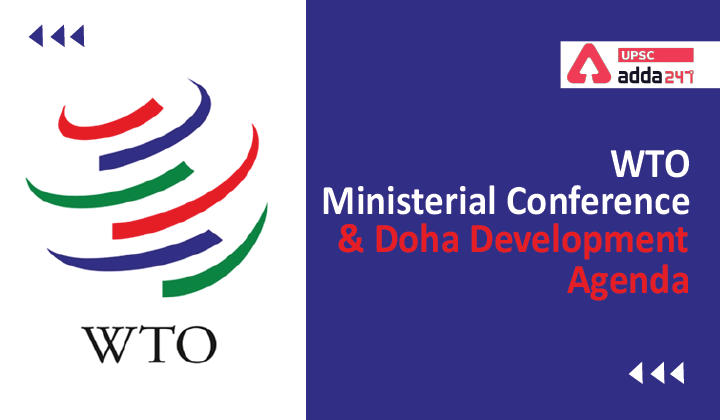Table of Contents
WTO Ministerial Conference: Relevance
- GS 3: Bilateral, regional and global groupings and agreements involving India and/or affecting India’s interests.
In the previous articles, we have dealt with WTO and the WTO agreements. In this article, we will discuss about the WTO Ministerial Conference and the Doha Development Agenda. All these articles are very important for the UPSC CSE Exam 2022.
WTO Ministerial Conferences
| Ministerial Conference (MC) | Place | Year | Important decision |
| MC1 | Singapore | 1996 | Ministerial declaration on trade in information technology products:
Expansion of world trade in information technology products, which account for 80% of world trade in these products. Singapore issues: transparency in government procurement, trade facilitation, trade and investment, and trade and competition. |
| MC2 | Geneva | 1998 | Declaration on Global Electronic Commerce: To establish a comprehensive work programme to examine all trade-related issues relating to global electronic commerce |
| MC3 | Seattle | 1999 | — |
| MC4 | Doha | 2001 | Doha Development Agenda (DDA): It covers negotiations on agriculture, Non-Agricultural Market Access (NAMA), services, dispute settlement, antidumping duties, subsidies, etc. Discussed separately below. |
| MC5 | Cancun | 2003 | — |
| MC6 | Hong Kong | 2005 | — |
| MC7 | Geneva | 2009 | — |
| MC8 | Geneva | 2011 | — |
| MC9 | Bali | 2013 | Bali Package: The centrepiece of the package is a new agreement on trade facilitation aimed at reducing red tape, and facilitating customs procedures in an effort to cut down the cost of doing business.
Other — less far reaching — aspects of the deal focused on food security and a set of issues of particular interest to least developed countries including trade preferences or cotton subsidies. |
| MC10 | Nairobi | 2015 | Nairobi Package: It contains a series of six Ministerial Decisions on agriculture, cotton and issues related to least-developed countries. |
| MC11 | Buenos Aires | 2017 | No consensus. Developed countries like US blocked a permanent solution on government stockholding for food security purposes, developing countries like India toughened its stand on new issues including e-commerce and investment facilitation. |
| MC 12 | Geneva | 2021 | To be held |
Doha Development Agenda
Market Access
Agriculture
- Agriculture has become the linchpin in the Doha Development Agenda.
- It aimed to give more market access to agriculture thus reducing government control over agriculture.
- It called for elimination of export subsidies and reduction of trade distorting domestic support.
- It also dealt with non-trade concerns like food security, rural development, among others.
- Special Safeguard Mechanism (SSM): It is a tool that will allow developing countries to raise tariffs temporarily to deal with import surges or price falls.
Non-Agricultural Market Access (NAMA)
- Non-Agricultural Market Access (NAMA) relates to trade negotiations on non-agricultural or industrial products.
- In the NAMA negotiations, WTO Members discuss the terms or modalities for reducing or eliminating customs tariff and non-tariff barriers on trade in industrial products.
Services
- It aimed to improve market access in trade in services.
- It also aimed to strengthen rules related to market access.
Development issues
On TRIPS Agreement
- Its purpose was to respond to the concerns that have been expressed that the TRIPS Agreement might make some drugs difficult to obtain for patients in poor countries.
Special and Differential (S&D) Treatment
- The WTO Agreements contain special provisions which give developing countries special rights and which give developed countries the possibility to treat developing countries more favourably than other WTO Members.
Also Read:





 TSPSC Group 1 Question Paper 2024, Downl...
TSPSC Group 1 Question Paper 2024, Downl...
 TSPSC Group 1 Answer key 2024 Out, Downl...
TSPSC Group 1 Answer key 2024 Out, Downl...
 UPSC Prelims 2024 Question Paper, Downlo...
UPSC Prelims 2024 Question Paper, Downlo...




